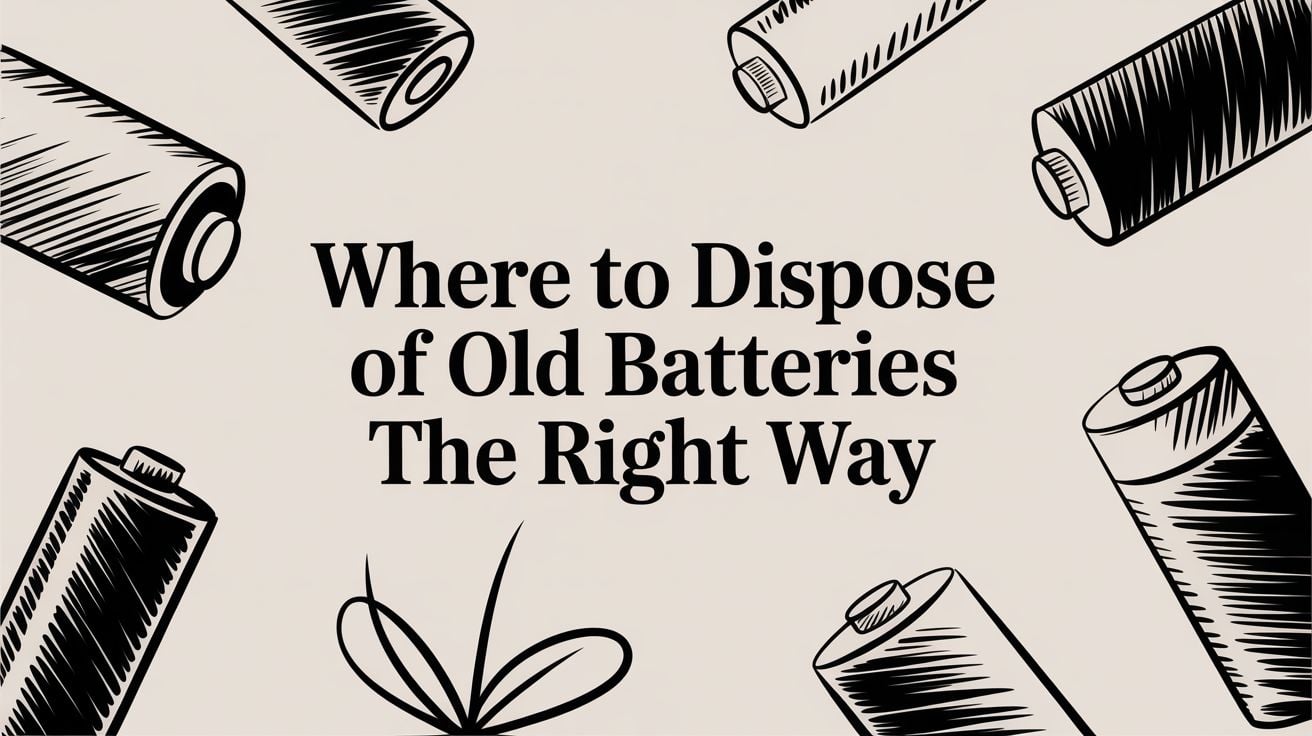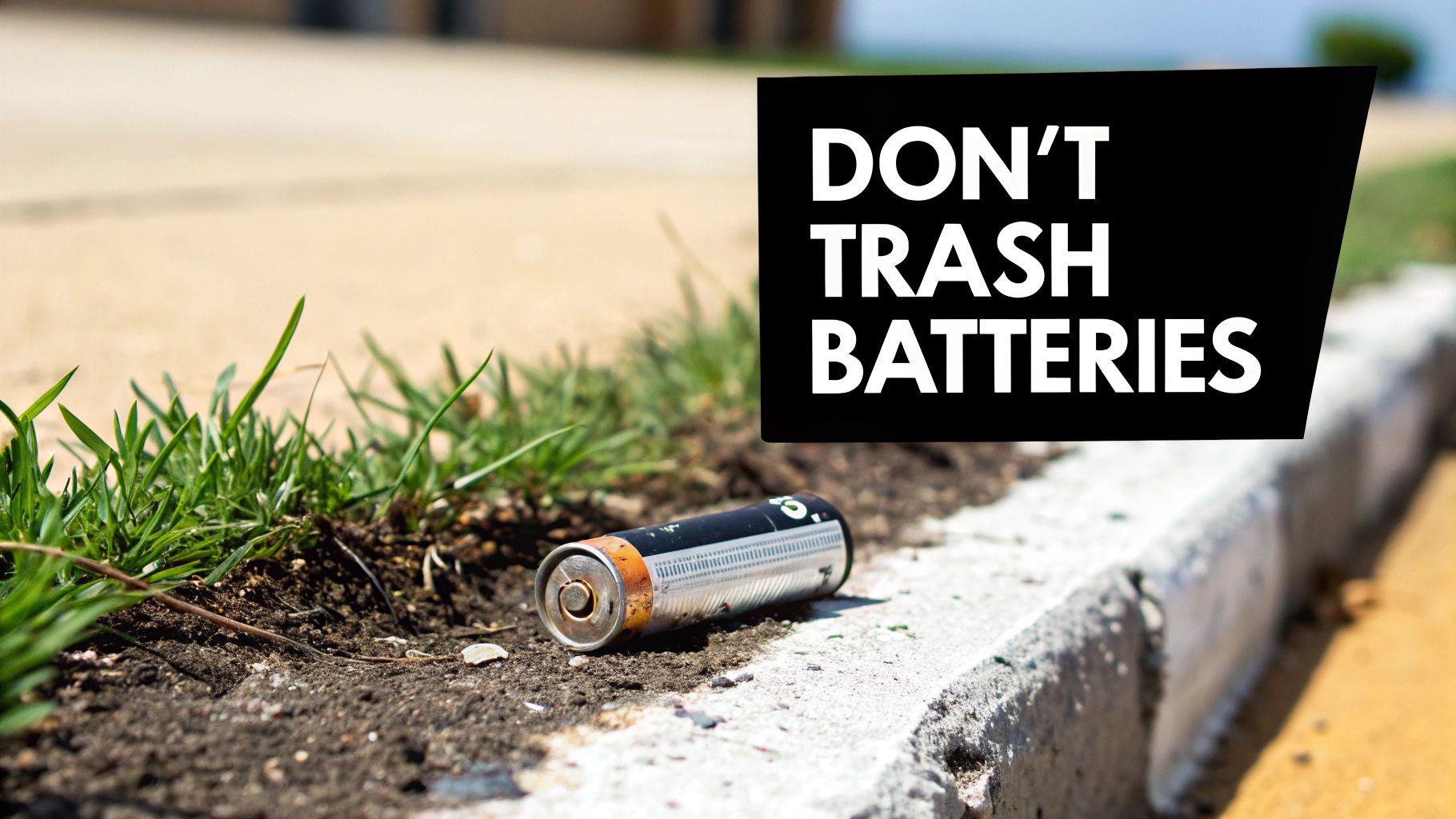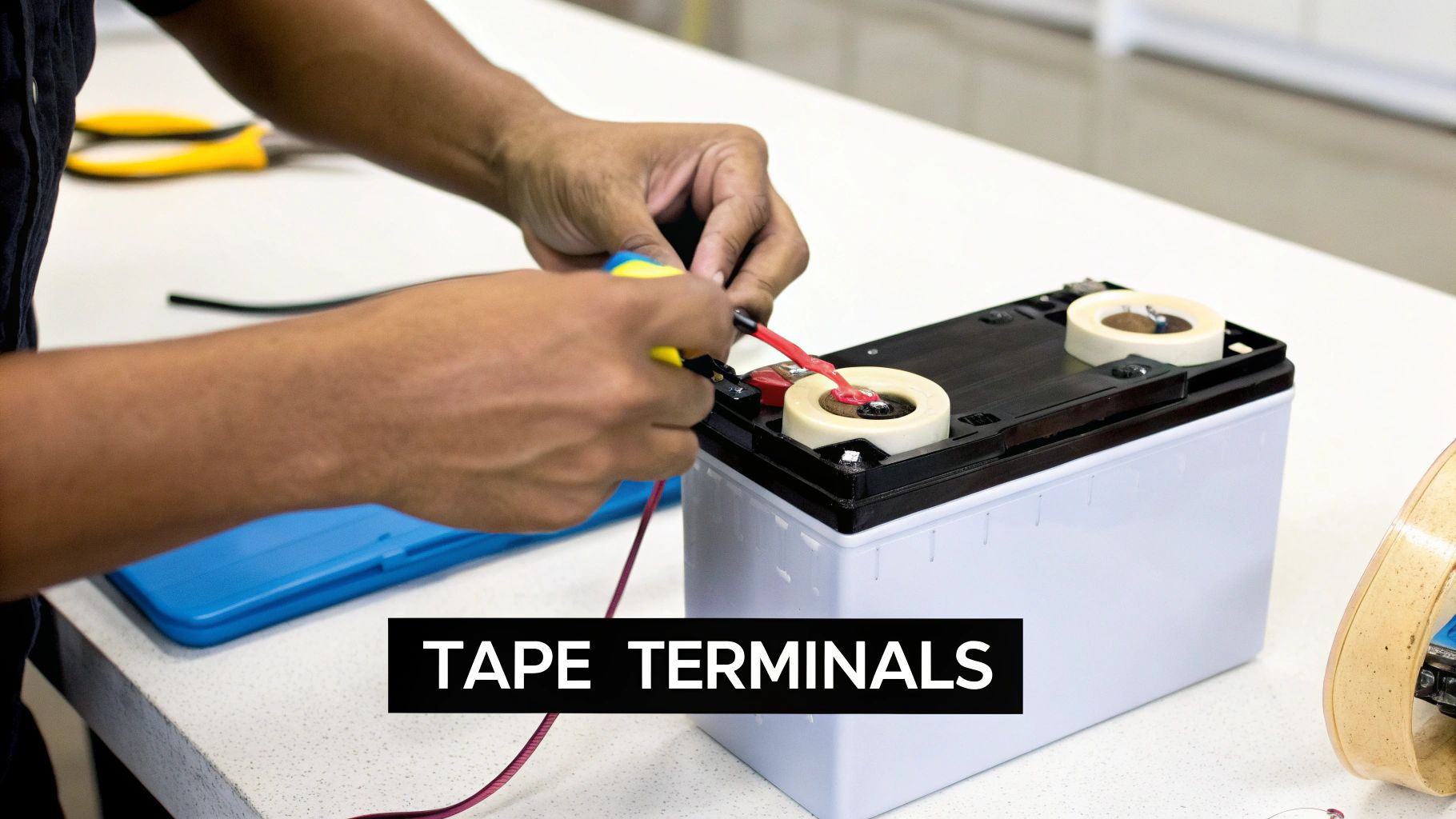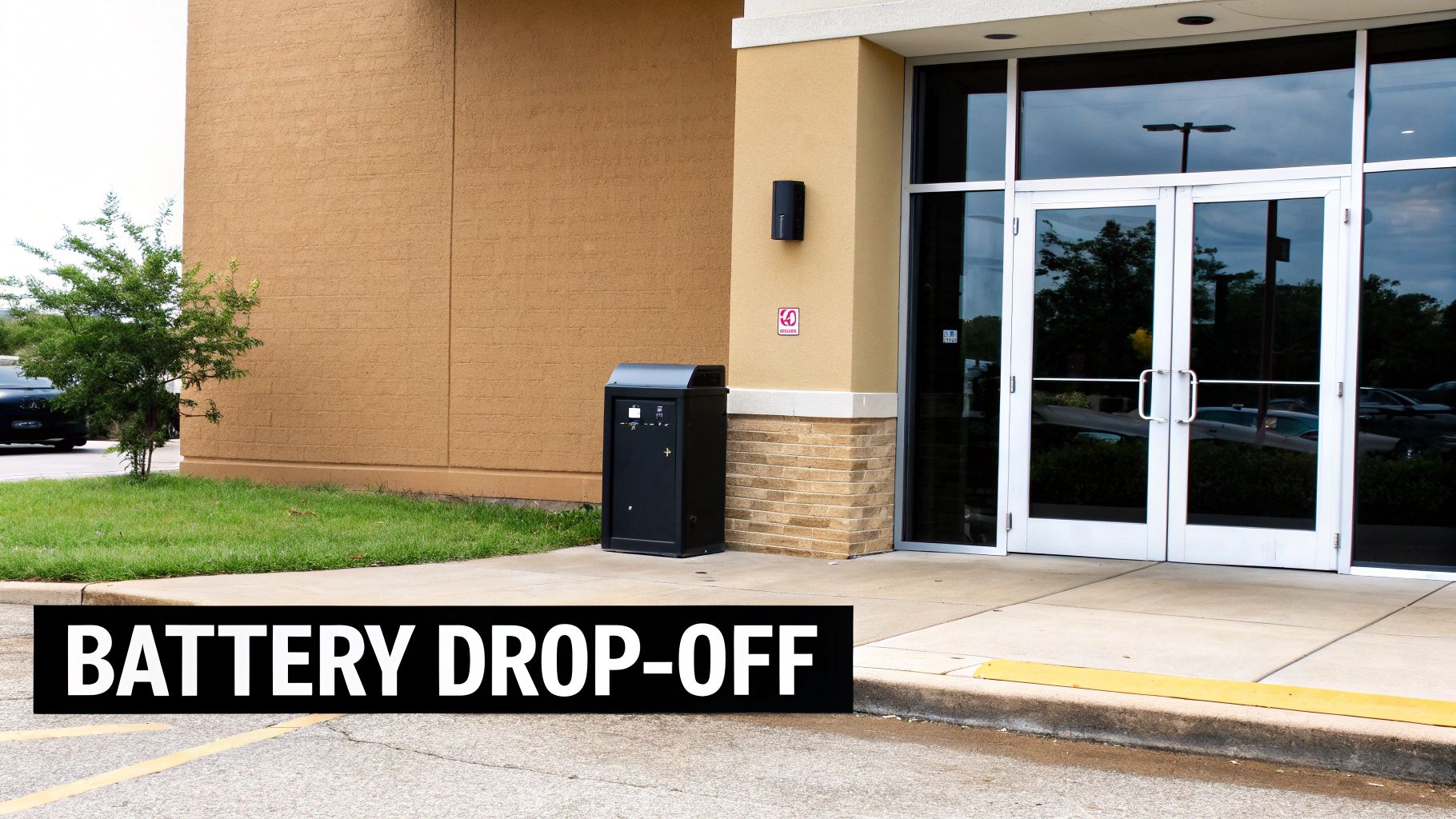
Where to Dispose of Old Batteries The Right Way
Before you toss that old battery in the trash, hold on. It might seem like a small thing, but where it ends up matters—a lot. It's not just about being green; it’s a major safety issue. If you're wondering where to dispose of old batteries, you've probably already got easy options nearby. Big-name stores like Best Buy, The Home Depot, and Lowe's usually have collection bins right at the front. For the trickier types, your local Household Hazardous Waste (HHW) facility is always the safest bet.
Your Quick Guide to Battery Disposal Locations
Let's be honest, figuring out what to do with a dead battery feels like a chore. But it’s a very important one. The average household has anywhere from 20 to 60 batteries lying around, powering everything from your remote to your smoke detector. When they die, the garbage can is the worst place for them.
Even a "dead" battery isn't completely empty. It still holds a little juice, and if the ends (the positive and negative parts) touch something metal, they can spark. That spark can easily start a fire. This is a real and growing problem, with fire departments reporting a huge spike in fires at recycling centers and in garbage trucks, mostly thanks to lithium-ion batteries being thrown away the wrong way.
Where to Take Your Old Batteries
The good news is, you have easy, and usually free, options right in your neighborhood.
- Big Box Retailers: Places like Best Buy, Staples, The Home Depot, and Lowe's have become fantastic hubs for battery recycling. You'll typically find their collection bins near the entrance or customer service desk, perfect for dropping off your old rechargeable batteries.
- Battery Specialists: Need to get rid of something more specific? Stores like Batteries Plus are set up to handle a much wider range, from car batteries and tiny button cells to even cracked or damaged ones.
- Your Local HHW Facility: For certain batteries—especially car batteries, non-rechargeable lithium ones, or very old alkaline batteries made before 1996—your town or county's Household Hazardous Waste (HHW) site is the way to go. They have the right tools to handle these materials safely.
This flowchart gives you a simple visual to follow.

The main thing to remember is that rechargeable batteries always need to be recycled. Single-use alkaline batteries (like AA or AAA) can sometimes go in the trash in certain areas, but your HHW facility is built to handle everything.
Crucial Safety Tip: Before you drop off any lithium or other rechargeable battery, grab some clear packing tape or electrical tape and cover the metal ends. It’s a tiny step that prevents them from touching and creating a serious fire hazard.
To make things even easier, here’s a quick reference table.
Quick Disposal Options for Common Battery Types
This table breaks down the most common spots to take your everyday batteries.
| Battery Type | Common Disposal Locations | Key Preparation Tip |
|---|---|---|
| Alkaline (AA, AAA, C, D, 9V) | Retail drop-offs, HHW facilities. Trash is okay in some (but not all!) states. | Tape the ends of 9V batteries to prevent them from touching. |
| Lithium-ion (Rechargeable) | Big box retailers (Best Buy, Lowe's), electronics stores, HHW facilities. | Always tape the ends. Never put these in the trash. |
| Button Cell (Watches, Hearing Aids) | HHW facilities, jewelry/watch stores, pharmacies, some retailers. | Tape both sides of the battery completely. |
| Lead-Acid (Car, Boat) | Auto parts stores, service centers, HHW facilities. | Keep upright and carry in a sturdy, leak-proof container. |
This should give you a solid starting point for getting rid of your old batteries the right way. It’s less about following strict rules and more about building a simple, safe habit.
It’s so easy to just toss a dead battery into the kitchen garbage and call it a day. Out of sight, out of mind. The problem is, what happens next can be incredibly harmful, both to our environment and to the people who handle our waste.

Think of a battery as a tiny power plant full of chemicals. Even when it can no longer power your remote, all those chemicals are still inside. When that battery's outer shell gets crushed in a landfill or a garbage truck, those substances leak out, causing a slow-motion environmental problem.
The Hidden Environmental Dangers
The real issue with just throwing batteries in the bin is the mix of harmful heavy metals they contain.
- Lead and Cadmium: These are the nasty ingredients in older rechargeable and car batteries. When they leak out of a landfill, they poison the soil.
- Mercury: While mostly removed from alkaline batteries since the mid-90s, mercury is still hanging around in button cell batteries. It’s a powerful poison you don't want anywhere near the water supply.
These materials don't just disappear. They can get into groundwater, which can eventually find its way into our drinking water and onto the fields where our food is grown. The scale of this is huge; the EPA estimates that in the U.S. alone, nearly three billion batteries are used every year. That’s a lot of potential poison.
Just like a workplace keeps a hazardous substance register for dangerous chemicals, we need to treat batteries with the same level of caution.
The Immediate Fire and Safety Risks
Beyond the slow environmental damage, there's a more immediate and explosive danger. This is especially true for the lithium-ion (Li-ion) batteries that power our smartphones, laptops, and cordless drills.
When these batteries get crushed or punctured—something that happens all the time in the back of a garbage truck or at a recycling facility—it can set off a violent reaction. This is basically an unstoppable, self-heating process that can cause the battery to catch fire, explode, or release toxic fumes.
It's a real-world scenario that plays out far too often. A sanitation worker crushes a load of trash, accidentally puncturing a discarded laptop battery. The battery sparks and sets fire to the dry paper and plastic around it. Suddenly, there’s a massive, dangerous fire in the truck, putting the worker and the public at serious risk.
According to waste management industry reports, fires caused by improperly disposed batteries at recycling and waste facilities have increased dramatically in recent years, with some facilities reporting multiple incidents per month.
This isn't just a "what if" problem; it’s a daily reality for sanitation workers. Disposing of these batteries correctly isn't just about being green—it's about protecting the lives of the people who handle our trash.
How to Safely Prepare Batteries for Recycling
Before you even start looking for a place to drop off old batteries, there's a key preparation step you can't skip. Taking a few minutes to get them ready isn't just about being tidy—it's a massive safety measure that protects you, your home, and the folks at recycling facilities from fire and chemical hazards.
Think of a "dead" battery as just sleeping. It still holds a bit of a charge, and if the metal contact points—the ends—touch another battery or something metal like your keys, it can spark. That little spark is especially dangerous with powerful lithium-ion batteries, where a simple connection can quickly lead to a fire.
Proper prep is simple, quick, and makes the whole process safer for everyone.

This kind of careful handling is a big reason why some recycling programs have been so successful. Take lead-acid car batteries, for instance. For decades, the focus has been on recycling them because of their size and valuable lead. These programs have seen incredible success, with recycling rates hitting nearly 99% in both the U.S. and Europe. It just goes to show what’s possible when safety and good incentives line up. You can read more about this established model over on Wikipedia's battery recycling page.
First, Know Your Battery Type
You can't prep a battery properly if you don't know what you're dealing with. A quick look at the label is usually all it takes.
- Alkaline Batteries: These are your standard, single-use AA, AAA, C, D, and 9-volt batteries that power your remote controls and flashlights. They're the most common ones you'll find around the house.
- Lithium-ion (Li-ion) Batteries: The rechargeable workhorses in your phone, laptop, power tools, and vape pens. They often come in custom shapes and sizes.
- Button and Coin Cell Batteries: Small, flat, and round. You'll find these in watches, hearing aids, car key fobs, and those greeting cards that play a little tune.
- Nickel-Metal Hydride (NiMH) or Nickel-Cadmium (NiCd): These are usually older types of rechargeable AAs or AAAs, often clearly marked as "rechargeable."
Identifying the type helps you understand the risk. While alkalines are lower risk, lithium-ion batteries demand the most attention and care.
The Single Most Important Tip: Tape the Ends
If you take only one piece of advice from this guide, let it be this: tape the ends on your rechargeable and lithium batteries. It’s the single best thing you can do to prevent them from sparking.
Grab some tape that doesn't conduct electricity—clear packing tape, electrical tape, or even duct tape will do the trick. Just stay away from anything metallic or decorative.
Pro Tip: For those little button and coin cells, the entire flat surface can act as an electrical contact. The safest move is to wrap the whole battery in a piece of clear tape, like you're making a tiny sandwich. This completely isolates it.
For regular cylinder-shaped batteries like AAs, a small piece of tape over the positive (+) and negative (-) ends is all it takes. For 9-volts, where both ends are on top, one piece of tape can easily cover both at once.
What to Do with Damaged or Leaking Batteries
Ever found a battery that’s bulging, swollen, or covered in a crusty white powder? That's a damaged battery, and it needs to be handled with extra caution.
Safety Steps for Damaged Batteries:
- Wear Gloves: Always put on protective gloves (rubber or similar) before touching it. That crusty stuff can irritate your skin.
- Bag It Up: Place the single damaged battery into a clear plastic bag and seal it. If you have some sand or kitty litter handy, tossing a bit in the bag can help absorb any leaking liquid.
- Keep It Separate: Never, ever mix a damaged battery in with your other recyclables. Store it by itself in a cool, dry place, far away from anything that can catch fire.
Don't try to "fix" a swollen battery or, worse, put it back on a charger. A damaged battery should go straight to a Household Hazardous Waste (HHW) facility, as the drop-off bins at your local hardware store aren't set up to handle them safely.
How to Store Batteries Before You Go
Once your batteries are all taped up and sorted, you need a safe spot to keep them until your next recycling run.
Find a container made of a non-metal material with a lid that closes securely. A plastic bucket, a glass jar, or a sturdy cardboard box works great. Steer clear of metal coffee cans or tins, as they could cause a spark if a piece of tape happens to fall off.
Tuck the container away in a cool, dry spot—away from sunny windows, heaters, or the stove. Most importantly, keep it well out of reach of children and pets. This simple routine makes it easy to collect batteries over time and keeps everything safe until you’re ready to drop them off.
Finding Battery Recycling Centers Near You
Okay, so you’ve done the prep work. Your old batteries are sorted, the ends are safely taped up, and they're stored properly. Now for the final, most important step: getting them to the right place.
The good news is that drop-off points are probably much closer than you think. They're often hiding in plain sight at stores you already visit. No need to go on a wild goose chase; a few clicks online will usually reveal a whole network of easy and free options.
Let's be honest, if recycling feels like a major chore, it's just not going to happen. Thankfully, a lot of organizations have worked hard to build partnerships that make responsible disposal as simple as a weekend trip to the hardware store.

Use Online Locators for Instant Results
The absolute fastest way to find a recycling spot is to use a special online search tool. These websites have teamed up with thousands of retailers and local governments to create complete, up-to-date maps of drop-off locations.
The biggest player in this space, and the one I always recommend first, is an organization called Call2Recycle.
Their locator tool is incredibly simple. Just pop in your zip code, and it pulls up a map with all the nearby collection sites. You’ll see a lot of familiar names on that list, as major retailers have become key partners in the battery recycling world.
You'll often find drop-off bins at places like:
- The Home Depot
- Lowe's
- Staples
- Best Buy
- Batteries Plus
These stores make it super convenient to drop off your old rechargeables while you're already out running errands.
Your Local Household Hazardous Waste Facility
While retail drop-offs are perfect for your standard rechargeable batteries, some types need a little extra care. This is where your local Household Hazardous Waste (HHW) facility comes into play.
These sites are run by your city or county and are specifically set up to handle materials that are just too dangerous for your regular trash can or recycling bin.
Make it a point to take these items to an HHW facility:
- Damaged, leaking, or bulging batteries of any kind. Seriously, don't mess with these.
- Car batteries (lead-acid), though most auto parts stores will happily take these off your hands, too.
- Non-rechargeable lithium batteries (the coin cells and AA/AAA types, not the rechargeable lithium-ion ones).
- Very old alkaline batteries made before 1996, as they might contain mercury.
Finding your nearest HHW site is easy. A quick search for "[Your City/County] household hazardous waste" will usually get you to the right government page. Just be sure to check their hours—many are only open on certain days or require an appointment.
Convenient Mail-In Programs
What if you live in a rural area, or you'd just rather handle it all from home? Mail-in programs are a fantastic solution. These services send you a specially designed, fire-resistant box that you can fill with old batteries at your own pace.
Once the container is full, you seal it up and ship it back with a prepaid postage label. This is a game-changer for businesses or even households that go through a ton of batteries. While you do have to pay for the container, the convenience can be well worth it.
Understanding the best way to handle old devices is a big part of this, and you can learn more about how to responsibly recycle electronics in our other guides.
Comparing Popular Battery Disposal Programs
With a few different routes to take, it can be helpful to see them side-by-side. I've put together this simple table to help you figure out the best fit for what you've got.
| Program Type | Best For | Commonly Accepted Batteries | Potential Cost |
|---|---|---|---|
| Retail Drop-Off | Everyday convenience for small batches. | Rechargeable batteries (Li-ion, NiMH, NiCd) and cell phones. | Free |
| HHW Facility | Damaged, old, or specialty batteries. | All types, including lead-acid, alkaline, and damaged cells. | Free for residents |
| Mail-In Program | High volume or maximum convenience. | Most household types, depending on the specific program. | Varies (cost of box/service) |
Ultimately, choosing where to dispose of your old batteries comes down to what you have and what's most convenient for you. With so many accessible options now available, from local stores to mail-in kits, there’s really no reason for another battery to end up in a landfill.
The Bigger Picture on Battery Recycling
When you tape the ends of a dead battery and toss it into a collection bin, it feels like a small, maybe unimportant, chore. But that simple action is the first step in a powerful global process that does way more than just keep toxic junk out of a landfill.
Recycling batteries is a direct investment in a cleaner, more sustainable future. It’s a key piece of what experts call the circular economy. Instead of the old "take-make-dispose" model—where we mine resources, use them once, and then trash them—recycling creates a loop. The valuable materials locked inside your old batteries get a second life, ready to be used to build new ones.
Turning Old into New
Just think about what’s packed inside a modern rechargeable battery. It’s a treasure trove of valuable materials that are very difficult and destructive to dig out of the earth.
- Lithium and Cobalt: These are the key ingredients in the powerful batteries powering our phones and electric cars. Mining them is a dirty business, often with major environmental and social problems.
- Nickel: A key player in many rechargeable batteries, nickel is another resource that requires massive amounts of energy to mine and process.
- Copper and Aluminum: Even these common metals, used for the outer shells and wiring, take far less energy to recycle than they do to create from scratch.
When you recycle a battery, these materials are carefully removed and cleaned, then sent right back to be used again. This directly cuts down on the need for new mining, which helps save our natural resources and prevents more damage to the environment.
By recovering these precious metals, we're essentially creating "urban mines" from our old gadgets. It's a much smarter, cleaner way to get the building blocks for the tech we all rely on every single day.
The Electric Vehicle Revolution Changes Everything
The massive global shift to electric vehicles (EVs) has made battery recycling more urgent than ever. An EV battery is a beast, packed with thousands of individual battery cells. As the first wave of EVs starts to reach the end of their life, we're about to face a huge number of powerful batteries that need to be handled responsibly.
But this challenge is also a huge opportunity. It’s creating an entire new industry focused on large-scale battery recycling. And this market isn't just growing; it's exploding. The global battery recycling market is expected to more than double, growing from roughly $19.56 billion in 2024 to over $41.66 billion by 2030.
In fact, recycled materials are expected to provide up to 15% of the world’s lithium need shortly after 2025. This will help stabilize prices and make us less dependent on a handful of mining hotspots around the globe. This kind of growth also creates thousands of green jobs in fields like shipping, chemistry, and engineering.
Initiatives like Canada’s Critical Battery Materials Initiative show how seriously governments are taking this, supporting the move to a more circular and secure supply of materials.
Every single battery you recycle plugs into this larger movement. It’s one small action that supports a massive shift in our economy and is a critical part of how we reduce electronic waste on a global scale. Your choice has a ripple effect, saving resources, protecting the environment, and helping to power a cleaner world.
Got Questions About Battery Disposal?
Even with the best intentions, figuring out what to do with old batteries can be confusing. It's totally normal to have questions when you're trying to do the right thing. Let's clear up some of the most common ones we hear.
What's The Right Way To Get Rid Of A Car Battery?
Car batteries are a whole different beast. Because they're filled with lead and acid, they are absolutely banned from landfills in almost every state. Never, under any circumstances, toss a car battery in your regular trash or recycling bin.
The good news? Recycling them is surprisingly easy, and you might even make a few bucks.
- Auto Parts Stores are Your Best Bet: Places like AutoZone, Advance Auto Parts, and Napa Auto Parts almost always take old car batteries. Most have a "core charge" system, meaning you get a credit or your deposit back when you bring in the old one after buying a new one.
- Your Mechanic Handles It: If a shop replaced your battery, they are responsible for recycling the old one. It's part of the service.
- Check with a Scrap Metal Yard: Some scrap yards will actually pay you for the lead in your old battery. The price changes, but it’s a nice little incentive to dispose of it properly.
When you're carrying a car battery, always keep it sitting upright in a sturdy, leak-proof container. You do not want that acid spilling.
Key Takeaway: The place you buy a new car battery is almost always the best place to return the old one. This closed-loop system works incredibly well, leading to a recycling rate of over 99% for lead-acid batteries.
Can I Just Throw Away Regular AA Batteries?
This is probably the question we get asked most, and the answer has changed over the years. For the standard alkaline batteries you use every day (AA, AAA, C, D, and 9-volts), the answer in most places is… yes, you can put them in the trash.
Since the mid-90s, manufacturers stopped using mercury, which made these batteries much less harmful. But just because you can, doesn't mean you should. Some places, like California, have much stricter laws that require all batteries to be recycled.
Even if it's allowed where you live, recycling is always the greener choice. It recovers steel and zinc, which means we don't have to mine as much new material.
Are All Rechargeable Batteries The Same?
Nope, and knowing the difference is key for safety. While all rechargeables need to be recycled, they are made of different chemicals and have different risks. The ones you'll run into most are:
- Lithium-ion (Li-ion): These are the powerhouses in your phone, laptop, and cordless drill. They're also the biggest fire risk if they get damaged or their ends touch.
- Nickel-Metal Hydride (Ni-MH): You'll find these in the shape of AAs or AAAs, often used in digital cameras or kids' toys.
- Nickel-Cadmium (Ni-Cd): This is an older technology, not as common now, but they still pop up in some older cordless tools and devices.
No matter the type, always tape the ends on all rechargeable batteries before you drop them off for recycling. This is especially important for Li-ion batteries to prevent them from causing a fire.
How Can I Cut Down On Battery Waste?
The single most effective thing you can do is simply use fewer disposable batteries.
Making the switch to rechargeable batteries for power-hungry devices like game controllers, digital cameras, and high-powered flashlights is a fantastic start. They cost a bit more upfront, but you can reuse them hundreds of times, which saves a ton of money and waste in the long run.
For your phone and laptop, the goal is to make the battery last as long as possible. Smart charging tools can stop the damage that comes from constant overcharging. Extending a battery's life is a powerful way to shrink your e-waste and carbon footprint—the significant CO2 savings from making devices last longer are proof of that.
By taking better care of your device batteries, you can make a real difference. Chargie helps you do just that, automatically managing your phone or laptop charging to prevent the wear and tear from overcharging. It can make a battery last up to four times longer, keeping your gadgets running like new for years and reducing the need for costly replacements.

